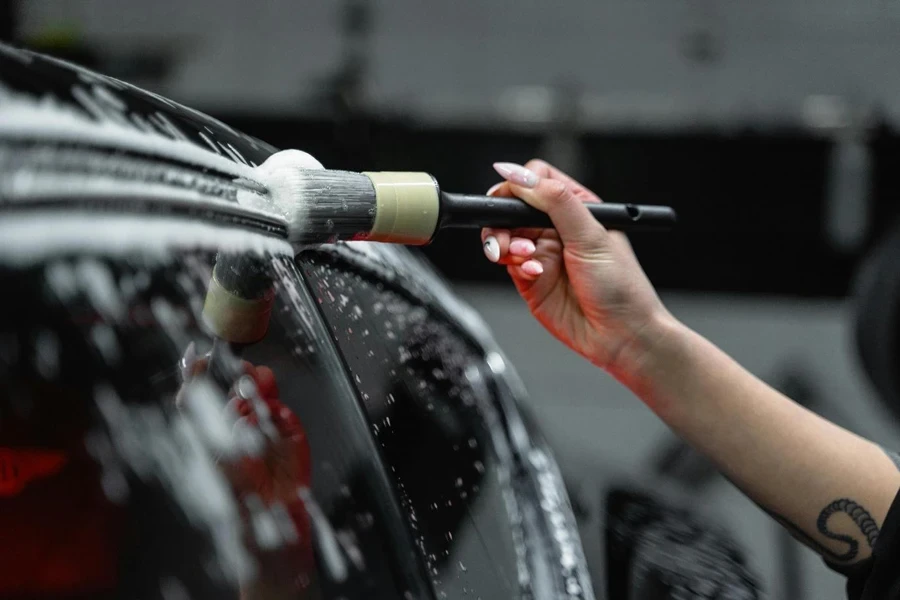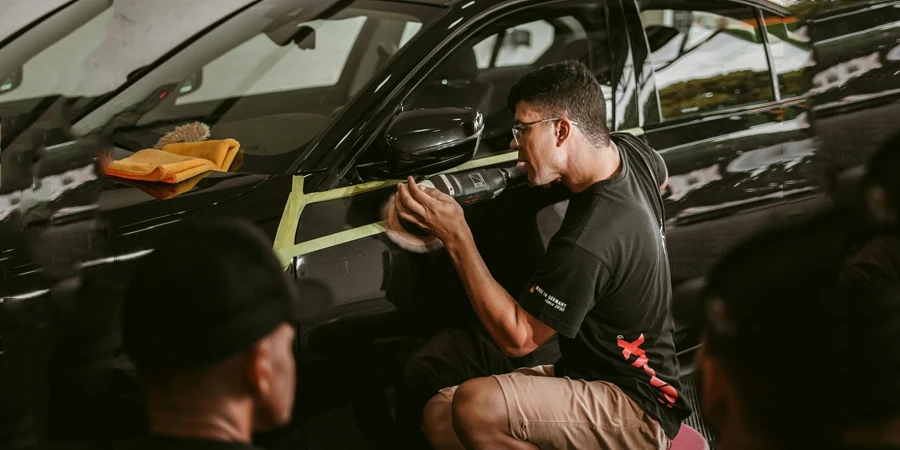Table of Contents
● Introduction
● Market overview
● Different types of car polishers
● Things to consider when selecting products
● Conclusion
Introduction

Car polishers are important in maintaining and re-creating the look of vehicles by eradicating blemishes and adding a glow. Today, the automobile industry continues to expand globally, so there is always a need for polishing tools that meet the requirements of professionals and those with basic knowledge of auto repair. Analyzing the market of polishers, including the types and characteristics of products available, assists organizations in making the right decisions when acquiring the polishers. Hitherto, business technologies and work designs have enhanced the performance and usability of polishers. Choosing the appropriate car polisher is critical to how effective the process will be and the beauty of the car’s look.
Market overview

Market scale and growth
According to the market analysis, the car polisher market worldwide was estimated to be at USD 338. 5 million in 2021 and is expected to reach USD 692.67 million in 2032 with a CAGR of 6.7%. This special growth results from increased car maintenance and detailing product usage. Market segmentation shows that electrical polishers reign in the market because of their lightweight, easy operation, and availability. In contrast, pneumatic polishers opt for their lightweight and high power-to-weight ratio. Automotive repair shops and automobile care shops mainly use car polishers, and these segments appear to dominate the market share in the forecast period.
Regional insights
Market research by region shows that North America constitutes a huge share of the market, primarily attributed to society’s fast pacing towards embracing car detailing services enhanced by improved income per capita. This dominance is complimented by constant innovation and improvement through research and development, thus introducing modern and easy-to-use polishing types of equipment. The policymakers that have supported better and safer car polishers through technological improvement, especially random orbital and dual-action polishers, have contributed to widening the converters. That is why their further market development may be expected as new needs of consumers and other professionals in auto engineering are being satisfied.
Different types of car polishers

Rotary polishers
Rotary polishers are widely known for their high performance, and the tool operates at high RPMs ranging between 600 and 4,000 RPM. Due to the high-speed rotation courtesy of motors with power outputs of between 1,100 to 1,600 watts, deep imperfections like heavy scratch lines or serious cases of oxidation can be promptly and efficiently eliminated. However, it is for the same reason as high RPM that careful handling is necessary so as not to cause some harm to the paintwork. These polishers normally have control speeds and progressive start features to control the speed and minimize any chances of sudden jerks at the beginning. They are fitted with large disc diameters, typically around 180mm, to serve the large surface areas well.
Dual action polishers
DA polishers are tools with oscillating and rotational action but work at fairly slower speeds of between 2,500 and 6,800 RPM. These machines have motors extracting power ranging from 300 to 900 watts to ensure power and control are well balanced. The two major actions help evenly distribute the heated and pressured condition, greatly minimizing the incidence or possibility of paint failure. Almost all DA polishers can regulate speed and are fitted with disc sizes stretching 125mm to 150mm. These are commonplace and, for general purposes, capable of performing average polishing and basic corrections, which are preferable for both the novice and the expert.
Orbital polishers
These polishers, also called random orbital polishers, are relatively easy to use since they move in an elliptical fashion. They usually run at slower RPMs, ranging from 1,500 to 6,000 rpm and come with motors of power ranging from 100 to 600 watts. Thus, with the random orbital motion, the polisher does not remain in one place, causing heat generation or paint damage. These polishers usually have speed controls and may have disc sizes between 150 mm and 240 mm; they are most suitable for providing a swirl-free finish in weakly scratched or oxidized panels.
Manual hand polishers
The manual hand polishers are basic and easy-to-handle devices for touching fine sections, which can’t be achieved with other enormous equipment. Unlike machine polishers, they lack a power source; hence, they are portable and easily used in small spaces. These polishers normally feature replaceable pads, incorporating foam, wool, or microfiber; the selection depends on the requirement: polishing, waxing, or buffing. Since manual hand polishers are not motorized, there is no danger of externally heating or pressuring the paint; hence, they are suitable for precise work.
Things to consider when selecting products

Power and speed
The wattage and the RPM of the car polisher are key factors that inform the efficiency and capacity of the tool on various tasks. Paint correction machines that are high powered come with power ranging from 1100 to 1600 watts. These suits paint correction processes requiring high RPMs between 3000-4000. These are suitable for offices, factories, and other places where severe scratch marks and high oxidation levels are the day’s order. Conversely, the dual action and orbital polishers produce power of between 300 and 900 watts and revolve at 2 500 and 6 800 RPMs; these are portable and safer for general use and light to medium correction.
Weight and ergonomics
Car polishers weigh between 2kg and well over 3.5kg, contributing somewhat to their impact on the users’ comfort and fatigue when used for extended periods. Heavier and more stable models do not wobble and possess greater power; however, some models are physically bulkier and can become a burden, especially when drawing on a wall or painting a huge area. Lightweight models are easy to use and maneuver, especially if they fall below 2.5 kg. Innovative design elements include an adjustable handle, a soft grip surface on the handle, and a symmetrical weight distribution, making the product comfortable and efficient and providing a uniform and firm polish.
Pad compatibility and accessories
Car polishers should be compatible with various pad accessories for other detailing tasks. The standard pad diameter is 125 to 240 millimetres; increased pad area is suitable for covering the surfaces faster, while smaller heads allow for better control of the pad while working in detail. Regarding the pad’s fastening system, the Velcro or threaded wedge should permit the pad’s fast change. Some of the polisher’s accessories include sanding plates, polishing bonnets, and backing plates, thus improving its flexibility. Foam, wool, and microfiber pads should also be compatible with the polisher to get the desired results when cutting, polishing, and finishing.
Thermal protection and safety features
Some thermal protection elements include auto shut-off mechanisms and cooling vents to ensure the motor does not overheat. This makes the polisher durable, and the machine will likely have a longer life span. Besides the safety features, the polisher has an anti-start switch to ensure that it does not start accidentally and progressive start functions that make it start at a low speed and then gradually increase, thus minimizing the chances of jerks and slips that may lead to paint damage. Also, ergonomic designs with non-slip grips and control places are safer than those with poor handling and control.
User skill level
It is important to choose a car polisher that will match the user’s experience since this determines the proper and safe use of the car polisher. Rotary polishers are powerful and can cause paint damage; hence, they are recommended for professional users with enough experience. The dual action and orbital polishers are more tolerant as they have both the power and the safety features that make the machine suitable for anyone from the experienced to the professional user. Some of these polishers have easy control features, and the action is not very forceful, thus minimizing the likelihood of causing damage. Non-powered manual hand polishers give the user better control and are suitable for close work and beginners who need to concentrate on small areas.
Conclusion

Choosing the right car polisher is crucial to get the desired results and meet automotive appearance objectives. It should depend on the need being met, the state of the car, and the level of competency of the user. Rotary polishers with high power are ideal for professionals dealing with severe imperfections on the surface to be polished, while dual action and orbital polishers provide an average performance for general use. Compact and comfortable designs and the ability to work with different kinds of pads increase convenience and productivity. Having safety and thermal protection features for the polisher also makes the polisher safe to use and, therefore, very suitable for any automotive detailing business.




